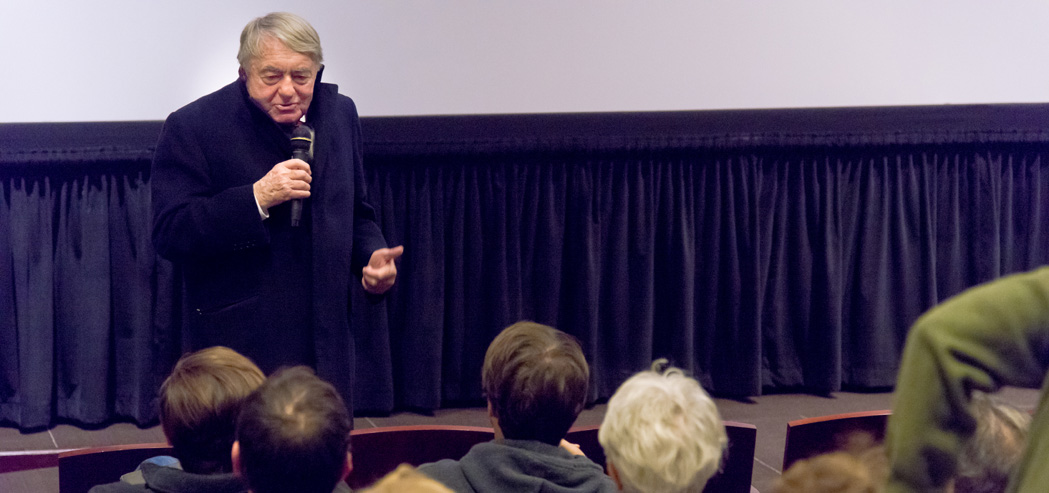The Last of the Unjust


Claude Lanzmann, right, and Stephen Smith during Lanzmann's visit to USC Shoah Foundation
French film director and documentarian Claude Lanzmann visited USC Shoah Foundation for the first time this December, bringing with him his latest film and a simple request for the future.
Lanzmann’s day, scheduled during the Los Angeles press tour for his new film, The Last of the Unjust, included a meeting with Executive Director Stephen Smith and director of research Karen Jungblut, a public screening of The Last of the Unjust followed by a discussion with the filmmaker at the USC School of Cinematic Arts.
Born in 1925 in Paris, Lanzmann became politically active at a young age, participating in the French Resistance movement at Blaise Pascal High School in 1943. He became friends with Jean-Paul Sartre and Simone de Beauvoir at the University of Berlin in the 1950s and began contributing to Les Temps Modernes, Sartre’s literary magazine. Today, Lanzmann is the magazine’s editor in chief.
Lanzmann, a staunch pro-Israel advocate, wrote and reported on various conflicts in Israel and the Middle East. He published a special issue of Les Temps Modernes dedicated to the Arab-Israeli conflict, and was indicted for his denouncement of repression in Algeria.
In 1970, Lanzmann switched to documentary filmmaking full-time. He worked on Shoah from 1974 to 1985. The nine-hour epic documentary changed forever the way in which the eyewitness would appear in film. Shoah continues to be hailed as one of the most significant documentary films ever made about the Holocaust.
Lanzmann’s later films continued themes close to his heart. Israel, Why (1973) examines the state of Israel just before the Yom Kippur War, and Tsahal (1994) is about the Israel Defense Forces. Sobibor, October 14, 1943, 4 p.m. (2001), is about a young man’s escape from the Sobibor death camp, and A Visitor From the Living (1999), about the falsified International Red Cross report on Theresienstadt.
The Last of the Unjust reveals and builds upon a week of interviews Lanzmann conducted with Rabbi Benjamin Murmelstein in Rome in 1975. Murmelstein was the last surviving head of the Jewish Council of the Theresienstadt ghetto, who battled Adolf Eichmann to prevent the liquidation of the ghetto and procure visas so thousands of Jews could escape. Because of his role as a leader of the ghetto and his close connections to Eichmann and other top Nazis, he remains a controversial figure, hated by many, who feel he betrayed his fellow Jews.
Michael Renov, vice dean of academic affairs at the USC School of Cinematic Arts, led discussion after the screening and asked Lanzmann to describe his impressions of Murmelstein.
Speaking to the audience at the school of cinematic arts, Lanzmann replied, “I was extremely aware of his magnificent intelligence, acute spirit, and readiness to answer my questions, even if they were not easy to answer, because I was not friendly with him on many occasions,” Lanzmann said. “I began to understand the fundamental problem of the councils, who were required to collaborate with Germans. They had no choice—no choice at all. The role of ‘collaborator’ is completely false to describe them and define their attitude.”
As the week of interviews with Murmelstein evolved, Lanzmann said he was more and more convinced that Murmelstein had been “unjustly accused by his Jewish brothers.”
When Renov asked whether the film is a “rehabilitation” of Murmelstein’s image, Lanzmann pointed out that Murmelstein is honest about all facets of his work with the Nazis—the good and the bad.
“[Murmelstein] gives all the weapons to condemn him, and he shows [everything to] help to understand him,” Lanzmann said.
In discussion with Smith and Jungblut, Lanzmann underscored his impression that Murmelstein had stood in the breach between the Nazis and the Jews. “He’s the only one who was courageous enough and intelligent enough to survive, to save the ghetto of Theresienstadt before this he succeeded to allow 23,000 Jews, Austrian Jews, to escape Austria [before the war]. It was a very difficult task. He had to negotiate with a monster like Eichmann.”
The Last of the Just has attracted controversy over whether Lanzmann intends to act as an apologist for Murmelstein. In a New York Times review of the film, Stephen Smith praised the film for being willing to tackle a deep and disconcerting matter. “This was Lanzmann giving [Murmelstein] a chance to clear his name, but one must not understate the complexity,” he said. “He’s good at discerning and getting to the bottom of the complexity of the Holocaust. It may not be desirable to everyone’s view, but I think it’s one we need to see and to grapple with. Not everything Murmelstein says is true, but it’s true to him.”
When Claude Lanzmann reviewed the Visual History Archive and the USC Shoah Foundation’s current work, he said, “It is perfect work…very important work. Many people and places in the world are viewing this, and there [will] be no end.”
Lanzmann had previously expressed skepticism about the Shoah Foundation. In 2010, The New York Times quoted him as saying of the Shoah Foundation’s 52,000 testimonies of Holocaust survivors and witnesses, “Who will see this?”
Reflecting on the relationship between the vast Visual History Archive of the Shoah Foundation and the detailed nature of The Last of the Unjust, Lanzmann said, “Sometimes there is a tendency to oversimplification. I don’t think of this as a critique; this means you have to dig more and more.”
Wolf Murmelstein, the son of Benjamin Murmelstein, gave testimony to USC Shoah Foundation’s Visual History Archive in 1998. To locate a Visual History Archive access site near you visit: http://sfi.usc.edu/locator
Like this article? Get our e-newsletter.
Be the first to learn about new articles and personal stories like the one you've just read.